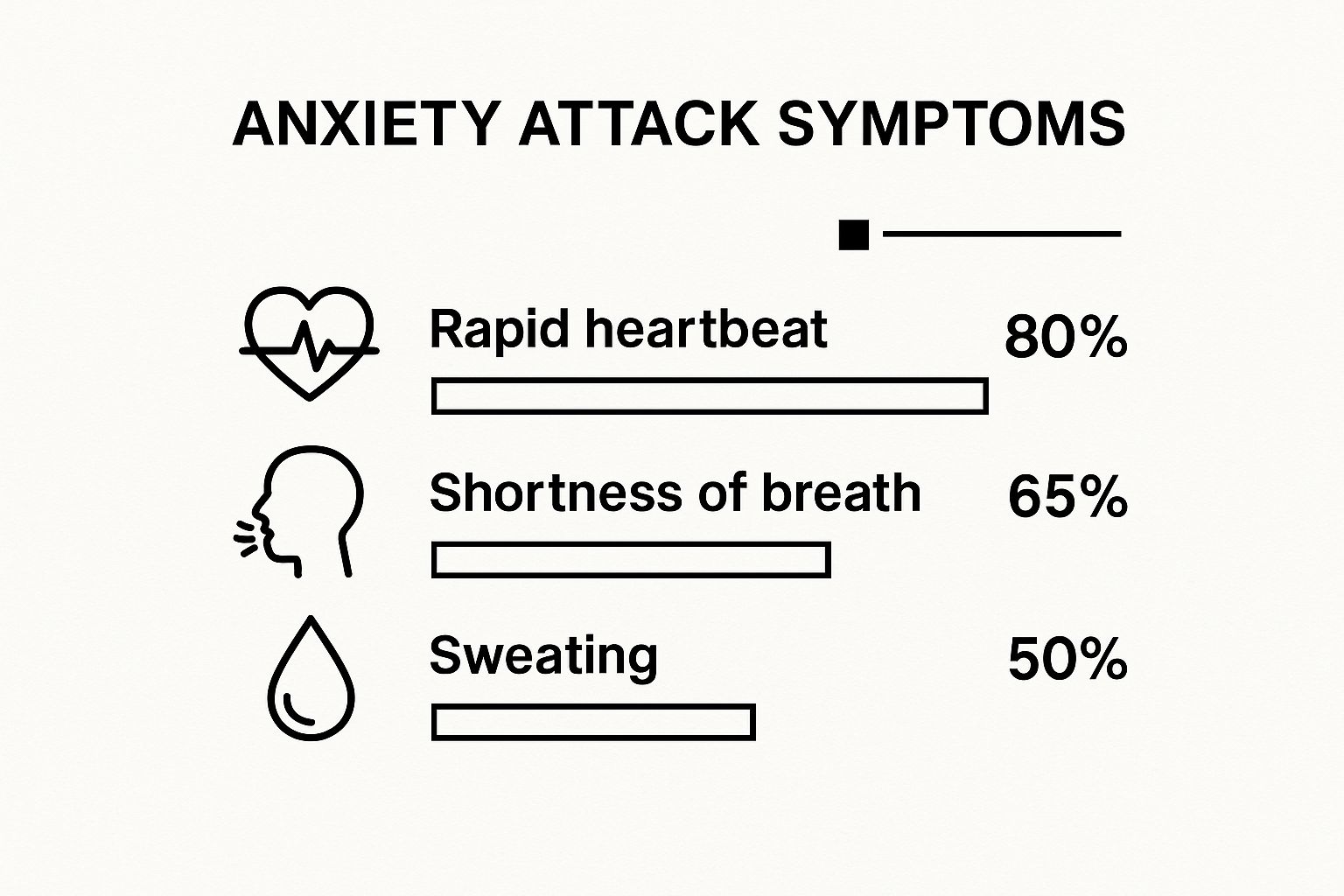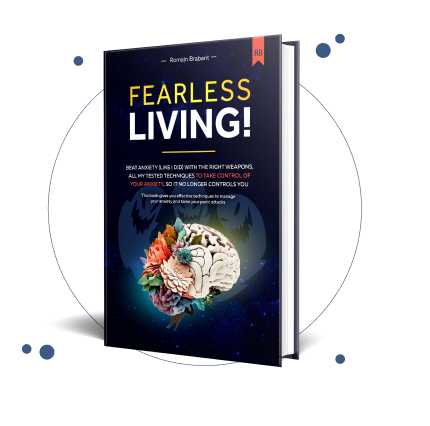
If you're wondering, "Am I having an anxiety attack?" you're likely in the middle of a terrifying wave of physical and mental symptoms that feel completely out of your control. Let me tell you something important right now: what you are feeling is real, it is temporary, and you can get through it. You are absolutely not alone, and there is a clear, hopeful path toward healing and living a life free from panic.
What an Anxiety Attack Really Feels Like
An anxiety attack feels like your body's internal alarm system is blaring at full volume, but there's no obvious reason why. It’s your ancient fight-or-flight response kicking into overdrive, prepping you for a danger that isn’t actually there.
Think of it like the smoke detector in your house. It’s a fantastic feature, designed to save you from a real fire. But sometimes, it goes off just because you burned some toast. An anxiety attack is like that smoke detector screaming "FIRE!" when there’s only a little smoke. Your body is just trying to do its job—a little too well.
This sudden surge of adrenaline unleashes a cascade of intense physical and emotional sensations that can leave you feeling completely overwhelmed and scared. But understanding what's happening under the hood is the very first step toward getting back in the driver's seat and starting your journey to recovery.

Common Signs Your Body's Alarm Is On
When an attack hits, your body is flooded with stress hormones. This leads to a host of powerful symptoms that can hit their peak within just a few minutes. It's a widespread experience, too; anxiety disorders are the most common mental health issue on the planet, affecting roughly 301 million people.
These sudden episodes show up in ways that are both intensely physical and deeply mental. Here’s a look at some of the most common signs.
In moments of high stress, it can be tough to make sense of what's happening. The table below breaks down the common symptoms into categories to help you quickly identify if what you're feeling lines up with an anxiety attack.
Quick Guide to Common Anxiety Attack Symptoms
| Symptom Category | Common Experiences |
|---|---|
| Cardiovascular | A pounding or racing heart, fluttering sensations, or feeling like it's beating irregularly. |
| Respiratory | A feeling of shortness of breath, like you can't get enough air, or a sensation of suffocating. |
| Neurological | Feeling dizzy, lightheaded, or unsteady, as if you might faint. Uncontrollable trembling or shaking. |
| Psychological | An overwhelming fear of losing control, a sense that you're "going crazy," or a profound dread that you might die. |
| Sensory | Numbness or tingling sensations (especially in hands and feet), chills or sudden hot flashes. |
Recognizing these symptoms for what they are—a false alarm from your body's protection system—is a game-changer. These feelings are definitely distressing, but they are not dangerous.
Seeing them this way is the start of your journey toward living a life with less panic. To learn more about the global scope of anxiety, check out the resources from the World Health Organization.
Is It an Anxiety Attack or a Heart Attack?
It’s one of the most terrifying questions you can ask yourself in a moment of intense fear: “Am I having a heart attack?”
The crushing sensation in your chest, the racing pulse, the struggle to catch your breath—it all feels incredibly real and dangerous. It’s no wonder so many people mistake an anxiety attack for a heart attack. While knowing the differences is no substitute for a doctor's diagnosis, it can be a powerful tool to dial down the fear when you're in the thick of it.
Reading the Signs: Chest Pain and Other Clues
One of the biggest clues is the nature of the chest pain itself.
A heart attack often feels like a crushing, squeezing pressure deep inside the chest. This pain isn't just stuck in one spot; it frequently radiates outward, traveling to the left arm, jaw, or back, and it tends to persist or even get worse over time.
In contrast, the chest pain from an anxiety attack is usually described as sharp or stabbing. It feels more localized—often right in the center of the chest—and typically fades as the wave of anxiety begins to pass.
Both can make your heart pound and leave you gasping for air, but an anxiety attack is more of a peak-and-valley experience. The symptoms usually spike hard and fast, reaching their peak within about ten minutes before they start to ease up. A heart attack, on the other hand, is a sustained medical crisis. Its symptoms don't just go away on their own.
Anxiety Attack vs. Panic Attack: Getting the Language Right
You’ll often hear people use "anxiety attack" and "panic attack" interchangeably, but there's a subtle yet important difference between them.
A panic attack is a sudden, overwhelming wave of fear that triggers severe physical reactions even when there’s no real danger. These often feel like they come out of absolutely nowhere. One minute you're fine, the next you're spiraling.
An anxiety attack, however, is usually tied to a specific stressor or a long period of worry. The anxiety builds more gradually, simmering over hours or days before it boils over into an intense peak. It's less of a sudden explosion and more of a slow burn reaching its climax.
If you want to dive deeper into what a panic attack feels like, our detailed guide can help you understand the specific signs of a panic attack.
This infographic highlights the top three physical symptoms people report during these intense episodes.

As you can see, a rapid heartbeat is the most common symptom, hitting 80% of people. This alone makes it crystal clear why the confusion with a heart attack is so frighteningly common.
To make things clearer, let's break down the key differences between these three events.
Comparing an Anxiety Attack, Panic Attack, and Heart Attack
When your body's alarm bells are ringing, it can be tough to figure out what's really going on. This table is designed to help you quickly spot the differences in symptoms, how they start, and how long they last. But remember, this is just a guide.
| Symptom | Anxiety Attack / Panic Attack | Heart Attack |
|---|---|---|
| Chest Pain | Usually sharp, stabbing, and localized in the center of the chest. Fades as the attack subsides. | Often a crushing, squeezing pressure. May radiate to the arm, jaw, neck, or back. |
| Onset | Can be sudden (panic attack) or build gradually from a known stressor (anxiety attack). | Symptoms often start slowly and persist or worsen over time. |
| Duration | Symptoms typically peak within 10 minutes and then gradually fade. | Symptoms are sustained and do not resolve on their own without medical intervention. |
| Accompanying Symptoms | Fear of dying or losing control, derealization (feeling detached), trembling, chills, or hot flashes. | Lightheadedness, cold sweat, nausea, shortness of breath, and pain in other areas of the upper body. |
Understanding these distinctions can give you a bit of clarity in a chaotic moment. However, it's vital to remember that symptoms can overlap, and taking a guess is never worth the risk to your health.
Crucial Takeaway: When in doubt, always seek immediate medical help. It is far better to have a false alarm with an anxiety attack than to dismiss the signs of a heart attack. Your safety is always the top priority.
Knowing these differences isn't about self-diagnosing; it's about empowerment. The more you understand your body's signals, the less power the fear holds. And lessening that terror is a huge step toward breaking the cycle of panic and getting back in control of your life.
Understanding Why Anxiety Attacks Happen
Anxiety attacks can feel like they come out of nowhere, completely derailing your day. But they don't happen in a vacuum. Think of an anxiety attack not as a random event, but as the tipping point after a long, slow buildup of stress, worry, and emotional weight. It's not a sign of weakness; it's a powerful signal from your body that your nervous system is simply overwhelmed.
Imagine your capacity for stress is like a bucket. Every single day, life adds a little water. Daily worries, a demanding job, relationship troubles, and financial pressures are all small drips that slowly raise the level. Bigger events—like a move, a job loss, or a health scare—can pour water in much faster.
Eventually, the bucket gets so full that one tiny, seemingly insignificant drop is all it takes to make it overflow. That overflow is the anxiety attack.
This is your first step toward hope. When you see these attacks as a reaction to a full "stress bucket," you can stop feeling like a helpless victim and start becoming an empowered observer of your own well-being. This is where real change begins.

Identifying Your Personal Triggers
Connecting the dots between what’s happening in your life and your body’s intense reaction is crucial. While triggers can be specific situations, they often tie back to deeper patterns of stress. Learning what fills your bucket is the key to preventing the overflow and healing.
Some of the most common contributors include:
- Chronic Stress: Constant pressure from work, school, or family can keep your nervous system stuck in high-alert mode.
- Major Life Changes: Even happy events, like getting married or starting a new job, are significant stressors that can fill your bucket quickly.
- Health Worries: Persistent anxiety about your health or a loved one's is a powerful and common trigger.
- Unresolved Trauma: Past traumatic events can leave your nervous system more sensitive, making it easier to feel overwhelmed by perceived threats.
This isn't just an individual experience; major global events can have a widespread impact. The COVID-19 pandemic, for example, triggered a 25% increase in the prevalence of anxiety and depression worldwide in its first year. The mix of social isolation, financial worries, and fear of infection was a massive, collective stressor that pushed many people’s nervous systems to the breaking point.
The journey to a panic-free life starts with compassionately understanding your triggers. It’s not about blame; it’s about awareness. This knowledge empowers you to make changes and build resilience.
To truly understand the triggers and patterns behind your anxiety attacks, it's essential to learn how to be more self-aware. Recognizing these patterns is a hopeful and proactive step. It allows you to address the root causes, which is a must for anyone who wants to learn more about managing the different types of anxiety disorders and living a calmer, more controlled life.
How to Regain Control During an Attack
When you’re in the middle of an anxiety attack, the feeling of losing control is often the scariest part. But here’s the most important thing to remember: you have more power than you think. You can’t always stop the wave from forming, but you can learn how to ride it without letting it pull you under.
This is your in-the-moment toolkit. These aren’t just theories; they are simple, practical actions you can take right now to anchor yourself. The goal is to give you back a sense of agency, proving that you can navigate these intense moments and come out safely on the other side. This is where hope begins to turn into real, lasting change.
Ground Yourself with the 5-4-3-2-1 Method
When an anxiety attack hits, your mind gets trapped in a whirlwind of fear—fixating on the future or what’s happening inside your body. Grounding techniques are designed to pull your focus out of that storm and back into the present moment. The 5-4-3-2-1 method is a powerful way to do this by engaging your five senses.
Here’s how it works:
- See 5 Things: Look around and name five different objects you can see. Notice their color, shape, and texture without judging them. Just observe.
- Feel 4 Things: Bring your attention to four things you can physically feel. It could be the texture of your jeans, the cool surface of a table, or the solid feeling of your feet on the floor.
- Hear 3 Things: Listen for three distinct sounds. Maybe it’s the quiet hum of a computer, birds chirping outside, or the sound of your own breathing.
- Smell 2 Things: Identify two different smells around you. It might be your coffee, a scented candle, or the clean scent of soap on your hands.
- Taste 1 Thing: Focus on one thing you can taste. You could take a sip of water, chew a piece of gum, or simply notice the current taste in your mouth.
This simple exercise forces your brain to switch from abstract fear to concrete, present-moment awareness, which helps calm your nervous system. For a deeper dive, check out our guide on other powerful grounding techniques for anxiety.
By intentionally engaging your senses, you are sending a direct message to your brain: "I am safe right here, right now." This is a fundamental skill in learning to manage anxiety and begin the healing process.
Your Path to Living a Panic-Free Life
Coping skills are a lifeline in the middle of an anxiety attack, but true freedom isn't just about weathering the storm—it's about building a life where those storms struggle to even form. This is where the real work, and the real hope, begins. The goal is to shift from just reacting to attacks to proactively creating a foundation of resilience and healing.
This isn't a quick fix, but it is an incredibly hopeful journey. It’s about gently understanding and rewiring the very thought patterns that fuel anxiety, leading you toward a life where you feel calm and in control.

Building Your Buffer Against Stress
Think of long-term strategies as creating a protective buffer around your nervous system. Every positive step you take adds another layer of defense, making you less vulnerable to the triggers that once sent you spiraling. These aren’t overwhelming tasks, but small, consistent habits that add up over time to create profound change.
You can start by weaving a few key practices into your routine:
- Consistent Exercise: Physical activity is one of the most powerful tools for flushing out stress hormones and boosting mood-stabilizing endorphins. Even a daily 20-minute walk can make a world of difference.
- Mindfulness and Meditation: These practices train your brain to stay grounded in the present instead of getting swept away by worries about the future. Just a few minutes a day helps quiet the mental static.
- Prioritizing Sleep: A well-rested brain is a more resilient brain. Aim for 7-9 hours of quality sleep a night. It's non-negotiable for regulating emotions and managing stress.
These lifestyle shifts work together to lower your baseline anxiety level. This gives you more emotional bandwidth to handle life's challenges without feeling like your "stress bucket" is about to overflow.
The Power of Professional Guidance
If you're asking, "Am I having an anxiety attack?" you are far from alone. In the UK, a staggering 37.1% of women and 29.9% of men reported high anxiety levels in 2022/23. Young adults aged 16 to 29 are especially affected, which shows just how common these intense experiences really are. You can find more details on these trends and anxiety statistics from The Priory Group.
Seeking professional help isn't a sign of weakness; it's a powerful, proactive step toward reclaiming your life. Therapies like Cognitive Behavioral Therapy (CBT) are exceptionally effective because they teach you to spot, challenge, and reframe the negative thought loops that trigger anxiety.
A therapist acts as a guide, giving you a map and the tools you need to find your way out of the panic cycle. They help you build the skills not just to cope, but to truly heal and thrive.
Working with a professional provides a structured, supportive space to make lasting changes. To get a clearer picture of your options, you can learn more about how psychotherapy for anxiety can create a personalized path toward recovery. This is a journey of empowerment—one that leads to a calmer, more fulfilling, and panic-free life.
When to Get Support for Anxiety
Knowing when to ask for help isn’t a sign of weakness; it’s an act of incredible strength. It's the first real step toward getting your life back. If anxiety attacks are starting to call the shots, that’s your cue to reach out for guidance. You don’t have to walk this path alone, and there is so much hope for a better future.
But how do you know when it's "bad enough"? It's a question a lot of people struggle with. The truth is, there are some pretty clear signals that it's time to take the next step.
Signs It Is Time to Seek Help
It’s time to think about professional support when anxiety is no longer just a brief storm but the constant weather in your life. Look out for these patterns:
- Increased Frequency: The attacks are happening more often. You feel like you're constantly walking on eggshells, just waiting for the next one to hit.
- Fear of the Fear: This is a big one. You’ve started to develop a persistent, nagging fear of having another attack, which just feeds the cycle of anxiety.
- Avoidance Behavior: Your world is getting smaller. You find yourself dodging places, people, or activities—like driving, going to the grocery store, or seeing friends—because you're terrified they might trigger an attack.
The goal of getting support isn't just to survive anxiety attacks. It's to build a life where they no longer have any power over you. A life free from panic isn't a fantasy—it's a realistic, achievable goal.
Finding Your Path Forward
Taking that first step can feel like a huge leap, but the process is more straightforward than you might think. A mental health professional, like a therapist or counselor, can give you a personalized plan to get back on your feet. They provide a safe, non-judgmental space to figure out your triggers and give you proven tools, like Cognitive Behavioral Therapy (CBT), to break the thought patterns that keep the panic cycle going.
The journey to healing is all about taking back your power. If you feel ready to see what your options are and find the right support, our guide can help you get help for anxiety now and connect you with the resources you need. Remember, asking for help is the most powerful thing you can do to reclaim your peace and live the full, fearless life you deserve.
Got Questions About Anxiety Attacks? We've Got Answers
It’s completely normal to have questions when you’re trying to understand something as intense as an anxiety attack. This last section is all about giving you clear, straightforward answers to the things people wonder about most.
The biggest takeaway here? You’re not broken. A life where you feel calm and in control isn’t just a nice idea—it’s absolutely within your reach.
Will Anxiety Attacks Just Go Away on Their Own?
A single, isolated anxiety attack might fade away without you doing much. But if they keep happening, it's usually a sign that there's an underlying pattern of stress that needs a little attention. Just waiting for them to disappear on their own can trap you in a cycle of fear.
The good news? You can learn powerful skills to dial down their intensity and make them happen way less often. Recovery isn’t a passive waiting game; it’s an empowered journey that you can start right now, and healing is entirely possible.
Are Anxiety Attacks Dangerous?
In the heat of the moment, an anxiety attack feels like the most dangerous thing in the world. Your body is screaming "danger!" and it's easy to believe it's a heart attack or something life-threatening.
But here’s the physical reality: an anxiety attack won't harm you. It's your body's alarm system going haywire, but the alarm itself isn't causing any damage. The real danger is the fear it leaves behind—a fear that can make your world feel smaller and smaller. Understanding that the sensations, while terrifying, are temporary and not physically harmful is a massive first step toward regaining your power.
Your most powerful tool is realizing that while the feelings are real, the threat is not. This single piece of knowledge is what starts to dismantle the fear and helps you build a foundation of lasting calm.
Can I Actually Be Cured of Anxiety Attacks?
Yes, absolutely. It's entirely possible to live a life where anxiety attacks no longer call the shots. The word "cure" can mean different things, but for most, it means building such strong resilience and having such effective tools that these attacks lose all their power.
Through consistent practice—grounding yourself, making small lifestyle shifts, and sometimes with a little professional guidance—you can actually rewire how your brain responds to stress. This isn't just about managing symptoms; it's about healing the roots. Hope isn't just a feeling; it's a strategy, and a life free from panic is a realistic goal you can work toward.
If you're ready to put that strategy into practice, The Anxiety Checklist is a step-by-step system designed to guide you. It's time to move from just surviving to truly thriving. Learn more about our Fearless Living program at https://anxietychecklist.com.

